▼ Researchers develop radio to track plane in real time [01-31-17]
 Researchers have developed a reconfigurable radio to help ATC see in real time regarding the location of planes flying in air, even across oceans. Researchers have developed a reconfigurable radio to help ATC see in real time regarding the location of planes flying in air, even across oceans.
For designing and developing the new reconfigurable, higher bandwidth radio, NASA collaborated with Palm Bay based Harris Corporation.
Thanks to real time global tracking, planes can fly with less space and take more direct routes.
This will not only improve public safety, but save fuel cost too, because aircrafts no longer have to remain in particular airline traffic lanes.
The biggest point is the flexibility of the radio. Both its hardware and software are completely reconfigurable.
The company can rapidly and cheaply redesigning the radio to fit the needs of the aircraft.
It will be used to create first space-based global air traffic control system.
The air traffic control agencies will be able to see in real time the location and heading of every plane in the air.
For decades, airplanes have relied on radar surveillance via land-based radar stations. This has led to mishaps like the missing MH370.
A constellation of 66 satellites, owned by Iridium Communications Inc., goes into orbit equipped with AppSTAR radios.
The radios are programmed to receive signals from new airplane transceivers called ADS-B, which automatically send out a flight's number.
It also provides location, heading and other details.
Within seconds you can keep track of all the aircraft in the world.
System will go live in 2018.
About NASA
- Formed: July 29, 1958
- Preceding agency: NACA (1915–1958)
- Jurisdiction: United States government
- Headquarters: Washington, D.C.
- Key official: Robert M. Lightfoot, Jr. (acting), Administrator
- Website: nasa.gov
|
▼ Pig and human stem cells combined to create transplantable organs [01-31-17]
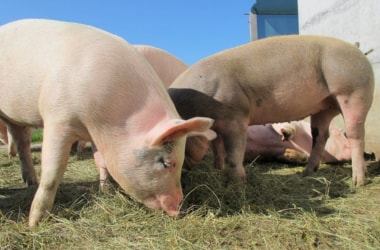 Scientists have grown embryos containing a combination of pig and human stem cells, possibly leading to growing transplantable organs. Scientists have grown embryos containing a combination of pig and human stem cells, possibly leading to growing transplantable organs.
Research remains at an early stage, but this is the first critical step. The ultimate aim is the growth of functional and transplantable tissues or organs.
Scientists have implanted adult human stem cells. These are called intermediate induced pluripotent stem cells. These have been combined with pig embryos and permitted to grow for four weeks.
The embryos a human animal mixture known as chimera after the mythical Greek species was terminated before it could be born.
Researchers found that human cells began to form into muscle tissue in pg embryos.
Notion of creating human animal mixtures has raised ethical questions. It could lead to the creation of animals with human qualities and intelligence.
Work will lead to understanding the evolution, development and disease and lead to remedy for organ shortages.
|
▼ Doomsday clock moves 30 seconds closer to midnight [01-31-17]
 US President Donald Trump's stand on nuclear weapons and climate change has made the world less safer, according to the Bulletin of Atomic Scientists. US President Donald Trump's stand on nuclear weapons and climate change has made the world less safer, according to the Bulletin of Atomic Scientists.
The Doomsday Clock has consequently moved closer to midnight by 30 seconds. The clock is a metaphor for how close humanity has come to destroying the planet.
It was last changed in 2015 from 5 to 3 minutes before midnight.
It is now set at two and a half minutes to midnight following rise in strident nationalism across the world.
The factors that have influenced this, according to scientists comprising 15 Nobel laureates include strident nationalism, Trump's stand on nuclear arms and climate issues and a growing global insecurity.
On the nuclear issue, Trump also added that the US must build up its nuclear arsenal.
The last time the Doomsday clock was this closer was 63 years back in 1953 after the USSR exploded its first hydrogen bomb, creating the modern arms race.
The Doomsday Clock was created in 1947.
It has changed 19 times since then, ranging from two minutes to midnight in 1953 to 17 minutes before midnight in 1991.
|
▼ ISRO launches GSLV Mk III cryogenic engine [01-30-17]
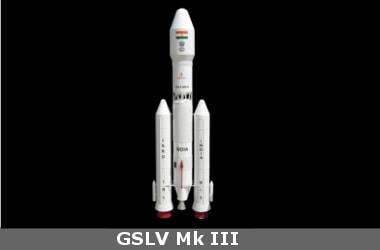 ISRO has successfully tested its indigenously developed cryogenic engine. ISRO has successfully tested its indigenously developed cryogenic engine.
This is a major step forward for its landmark 'GSLV Mk III' rocket.
The rocket is scheduled for launch within the first quarter this year.
Cryogenic engines are used in the upper stage of a rocket launch.
They provide the maximum thrust to a launcher vehicle.
The cryogenic upper stage, designated as C25, was tested on January 25.
It was tested for 50 seconds at ISRO Propulsion Complex (IPRC) at Mahendragiri in Tamil Nadu.
This was the first test in a series of two tests. The next one was planned for a flight duration of 640 seconds.
The 50 second test is a significant milestone in the development of indigenous cryogenic propulsion technology.
Successful hot test of the stage in the first attempt itself demonstrates the agency's ability to work in new areas like cryogenic technology.
The development of C25 cryogenic stage began with the approval of GSLV MkIII.
This is the next generation launch vehicle of ISRO, capable of launching 4 ton class spacecraft in Geosynchronous Transfer Orbit (GTO).
The vehicle consists of two solid strap-on motors, one earth storable liquid core stage and the cryogenic upper stage.
The C25 stage is the most powerful upper stage developed by ISRO.
It uses Liquid Oxygen and Liquid Hydrogen propellant combination.
The stage carries 27.8 tons of propellants loaded in two independent tanks.
The first flight stage for 'GSLV MkIII-D1' mission is in an advanced stage of realisation.
It is scheduled to launch GSAT-19 during first quarter of 2017.
The flight engine has been successfully tested in the High Altitude Test facility.
It is integrated with the flight stage, ISRO said.
The C25 stage was conceptualised, designed and realised by Liquid Propulsion Systems Centre (LPSC), ISRO's lead Centre for Propulsion.
There is support from various System Development Agencies from other three Centres of ISRO -
- Vikram Sarabhai Space Centre (VSSC),
- ISRO Propulsion Complex (IPRC) and
- Sathish Dhawan Space Centre (SDSC).
GSLV MkIII vehicle consists of two solid strap-on motors, one earth storable liquid core stage and the cryogenic upper stage. The C25 stage is most powerful upper stage developed by ISRO. It uses Liquid Oxygen and Liquid Hydrogen propellant combination. This stage carries 27.8 tons of propellants loaded in two independent tanks. Note: What is a Cryogenic Engine C-25?- Cryogenic engines are used in the upper stage of the rocket launch.
- They provide the maximum thrust to the launcher vehicle.
- Development of a cryogenic stage has unique design challenges liquid Oxygen stored at -195 deg C and as liquid Hydrogen is stored at -253 deg C in its tanks.
- To store these cryogenic fluids, special multi-layer insulation is provided for the tanks and other structures.
- The successful hot test of the stage in the first attempt itself demonstrates the ISRO’s ability to work in new areas like cryogenic technology.
- The first flight stage for ‘GSLV MkIII-D1’ mission is in an advanced stage of realisation.
- It is scheduled to launch GSAT-19 during first quarter of 2017.
|
▼ TSRI scientists create first stable semi synthetic organism [01-30-17]
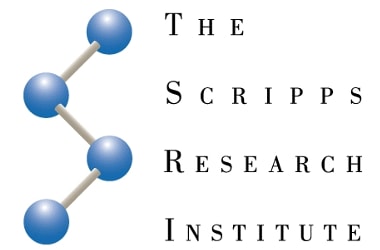 Scripps Research Institute (TSRI), US scientists have created world’s first stable semi-synthetic organism. Scripps Research Institute (TSRI), US scientists have created world’s first stable semi-synthetic organism.
This is a single-celled bacterium with an expanded genetic code
The semi-synthetic organism is the modified E.coli bacteria created by introducing DNA molecules.
These are not found in nature in a common bacterium.
Life’s natural genetic code only contains four natural bases- adenine (A), cytosine (C), guanine (G), thymine (T).
These bases pair forms two base pairs in the DNA ladder.
The newly created bacterium has two human-created X and Y bases that grow and divide, much like the four natural bases.
This single-celled organism can attach to the synthetic base pair as it divides.
The human-created X and Y base pair was dropped over time in the bacterium that limited the ways the it can use the additional information possessed in their DNA.
For this, researchers had optimised a tool called a nucleotide transporter.
This brings the materials necessary for the unnatural base pair to be copied across the cell membrane.
They discovered that modification to the transporter, made it much easier for the organism to grow and divide.
This is while holding on to X and Y.
Researchers used gene editing tool CRISPR-Cas9 to design the synthetic organism to see a genetic sequence without X and Y as a foreign invader.
Organisms with wholly unnatural attributes and traits that are not found elsewhere in nature can be created.
In future, it can help in creation of microbes capable of manufacturing entirely new proteins.
This is an innovation which can provide leads to new medicines and nanotechnology breakthroughs.
|
▼ NASA's New Horizon to explore Kuiper Belt object 2014 MU69 [01-27-17]
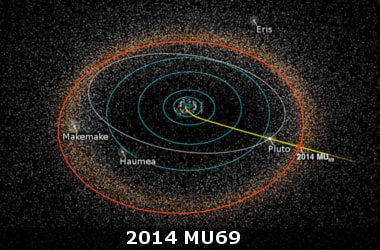 NASA's New Horizon spacecraft is set to explore small ancient object 2014 MU69 discovered by Hubble Space Telescope in 2014. NASA's New Horizon spacecraft is set to explore small ancient object 2014 MU69 discovered by Hubble Space Telescope in 2014.
This object is located 1.6 billion km beyond Pluto.
The object is in the Kuiper Belt, a distant region that surrounds the solar system and is filled with trillions of icy rocks that have yet to be explored.
The spacecraft took about 16 months to beam back all of the data from the Pluto flyby and planetary scientists are studying the developments.
The next big stage of the mission, the flyby of 2014 MU69, will occur in January 2019.
MU69 is much smaller and more representative of the trillions of other KBOs.
Pluto is comparable to the size of North America at 2,370 km in diameter.
MU69 is less than 45 km across. It has a special kind of orbit that makes it possibly a type of object that is primordial and left over from early solar system formation.
About the Kuiper Belt
- The Kuiper belt is sometimes called the Edgeworth–Kuiper belt.
- It is a circumstellar disc in the Solar System beyond the planets.
- It is extending from the orbit of Neptune (at 30 AU) to approximately 50 AU from the Sun.
- It is similar to the asteroid belt, but it is far larger - 20 times as wide and 20 to 200 times as massive.
- The Kuiper belt is home to three officially recognized dwarf planets: Pluto, Haumea, and Makemake.
- Some moons, such as Neptune's Triton and Saturn's Phoebe, are also thought to have originated in the region.
|
▼ Pakistan launches long range surface-to-surface ballistic missile Ababeel [01-25-17]
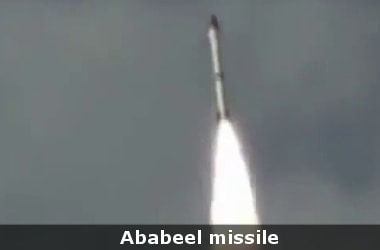 Pakistan conducted the first flight test of long range surface-to-surface ballistic missile Ababeel. Pakistan conducted the first flight test of long range surface-to-surface ballistic missile Ababeel.
The missile launched on 23rd Jan 2017 has capability to carry nuclear warheads. It can also engage multiple targets with high precision, defeating the enemy’s hostile radars.
The missile has a maximum range of 2,200 Km. It uses Multiple Independent Re-entry Vehicle (MIRV) technology/
The aim is deterrence.
On January 9 2017, Pakistan had conducted a test-firing of submarine-launched cruise missile “Babur-3.” This is having a range of 450 Km.
Know More About Babur 3
- Babur-3 is a sea-based variant of cruise missile Babur-2.
- It was successfully tested in December 2016.
- It incorporates state-of-the-art technology.
- It has water controlled propulsion and advanced guidance and navigation features.
- This is augmented by Global Navigation, Terrain and Scene Matching System.
- It also features terrain-hugging and sea-skimming flight capabilities to evade hostile radars.
Ababeel: Know More
- Type: Surface-to-surface ballistic missile
- Place of origin: Pakistan
- Used by: Pakistan Army Strategic Forces Command
- Produced: 2017
- Operational range: 2,200 kilometre
|
▼ New medical testing for faster diagnosis of HIV, other diseases [01-24-17]
 Scientists have developed a new method for medical testing. Scientists have developed a new method for medical testing.
This may lead to faster diagnosis of HIV, Lyme disease, syphilis and rotavirus infections.
Researchers combined cutting-edge nanoscience with a magnetic process discovered more than 170 years ago to create the method for speedy medical tests.
The team coated nanoparticles with the antibody to BSA, or bovine serum albumin. This is an antibody which is commonly used as the basis of a variety of diagnostic tests.
By mixing the nanoparticles in a test solution, the BSA proteins preferentially bind with the antibodies coating the nanoparticles.
Nanoparticles were used with an iron core and applied a magnetic field to the solution, causing the particles to align in a particular formation.
As proteins bind to the antibody-coated particles, the rotation of the particles becomes sluggish, which is easy to discover with laser optics.
The discovery, if commercialised, could lead to faster test results for HIV, Lyme disease, syphilis, rotavirus and other infectious conditions.
At the core of the research are nanoparticles - tiny particles that are one-billionth of a meter.
Application of Faraday Rotation: Know More
- The interaction of a magnetic field and light is known as Faraday rotation.
- This is a principle discovered by scientist MichaelFaraday in 1845.
- Putnam adapted it for biological use.
- Method could be used to produce biochemical immunology test results in as little as 15 minutes, compared to several hours for ELISA, or enzyme-linked immunosorbent assay.
- This is currently a standard approach for biomolecule detection.
|
▼ Star Wars Missile Killer System by Israel - Know More [01-23-17]
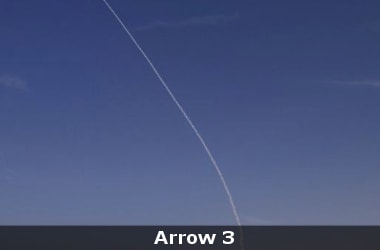 Israel’s upgraded ballistic missile shield Arrow 3 became operational w.e.f 22nd Jan 2017. Israel’s upgraded ballistic missile shield Arrow 3 became operational w.e.f 22nd Jan 2017.
The “Star Wars”-like extension of its capabilities to outer space ensures incoming missiles can be safely destroyed.
Defence Ministry of Israel has stated the US funded Arrow 3 System has been jointly developed by State operated Israel Aerospace Industries and US Firm Boeing Co.
It was handed over to the Israeli Air Force on 18th Jan 2017. The delivery and advanced operational capability of the highly advanced defence system was announced on this date too.
Arrow-3 is under the US-Israel Arrow Weapon System.
The Iron Dome, developed by Rafael Advanced Defense Systems, defends Israel from short-range rocket and other aerial assaults up to 43 miles away.
But the new system takes Israel’s defense capabilities into outer space.
The Arrow-3 stands as one of the most advanced missile defense system in the world.
It aids Israel in fending off long-range missiles, including taking down targets in space.
New missile has half the weight of Arrow-2 and has better operational capabilities. It has nailed a simulation designed to replicate long range missiles possessed by Islamic forces.
The warhead of the missile splits off and becomes a kill satellite to track down intended targets in space.
Arrow-3: Know More
- Arrow 3 intercepts ballistic missiles, especially those carrying weapons of mass destruction.
- It attacks ballistic missiles traversing at altitudes of over 100 km and in greater ranges.
- It could also be ship-based.
- Faster than Arrow 2, it is slightly smaller weighing nearly half.
- An Arrow 3 battery is expected to intercept salvos of more than five ballistic missiles within 30 seconds.
- Arrow 3 can be launched into an area of space before it is known where the target missile is going.
- Arrow 3 has the same launch system as Arrow 2.
- Reportedly it cost $2–3 million per unit.
|
▼ Robotic heart sleeve to help human heart beat! [01-23-17]
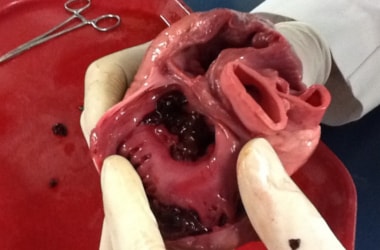 Harvard researchers along with scientists from Boston Children's Hospital have developed a customizable robotic heart sleeve that helps hearts to beat. Harvard researchers along with scientists from Boston Children's Hospital have developed a customizable robotic heart sleeve that helps hearts to beat.
This opens up new treatment for heart failure patients.
Soft robotic sleeve twists and compresses in sync with a heart beat. This augments cardiovascular functions weakened by heart failure.
Current available devices that help heart beat directly come in contact with blood.
The soft robotic sleeve does not directly contact blood, lowering the risk of clotting.
It also eliminates the need for blood thinner medication. The latter can be dangerous.
Device can help patients transplant or aid in cardiac rehab and recovery.
This showcases the potential of soft robotics to meet clinical needs.
The inventor of the heart sleeve is Ellen T. Roche and her team.
The research, was a collaboration between Harvard, the Wyss Institute, and Boston Children’s Hospital.
It shows how soft robotics can safely interact with soft tissue and lead to improvements in cardiac function.
The thin silicone sleeve uses soft pneumatic actuators placed around the heart.
It mimics the outer muscle layers of the mammalian heart.
The actuators twist and compress the sleeve in a motion akin to the beating heart.
The device is tethered to an external pump. This uses air to power the soft actuators.
The sleeve can be customized for each patient, as his/her condition evolves.
The sleeve is attached to the heart using a combination of a suction device, sutures, and a gel interface.
This helps with friction between the device and the heart.
Heart Failure: Know More
- Heart failure affects 41 million people worldwide.
- Today, some of the treatment options are mechanical pumps called ventricular assist devices (VADs).
- These pump blood from the ventricles into the aorta, and heart transplants.
- While VADs are continuously improving, patients are still at high risk for blood clots and stroke.
|
▼ Smart needle helps neurosurgeons see where they insert the needle [01-23-17]
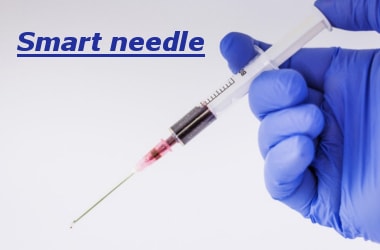 Scientists have developed a new smart needle with a tiny camera that permits surgeons to see at-risk blood vessels. They can avoid injuring these. Scientists have developed a new smart needle with a tiny camera that permits surgeons to see at-risk blood vessels. They can avoid injuring these.
The advance is set to make brain surgery safer.
The minute imaging probe encased with a brain biopsy needle ensures that surgeons see blood vessels while inserting the needle.
This will help them to avoid bleeds that can have the potential to be fatal.
It is a smart needle with a tiny fibre optic camera the size of a human hair. It shines infrared light to see the vessels before the needle can cause any damage.
Computer itself attached to the smart needle recognises blood vessels and alerts the surgeon. Smart needle will be ready for clinical trials in the coming year.
To have a tool that recognises blood vessels as one proceeds through the brain would revolutionise neurosurgery.
It will increase the chances of safer surgery.
|
▼ Wolf 1061c: Potential habitable exoplanet discovered [01-23-17]
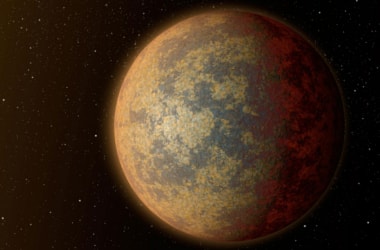 Astronomer Stephen Kane from San Francisco State University, US has studied an exoplanet called Wolf 1061c . Astronomer Stephen Kane from San Francisco State University, US has studied an exoplanet called Wolf 1061c .
It was found that it could be habitable. Its orbit changes at a faster rate unlike Earth, which may cause its climate to be quite chaotic.
His study was focused on finding “habitable zones” where water could exist in a liquid state on a planet’s surface.
The planetary system of Wolf 1061c is located 14 light years away.
One of the three known planets in the Wolf 1061 system, a rocky planet called Wolf 1061c, is entirely within the habitable zone.
When scientists search for planets that could sustain life, they are basically looking for a planet with nearly identical properties to Earth.
According to Kane, life is possible on Wolf 1061c under one possibility - the short time scales over which Wolf 1061c's orbit changes could be enough that it could actually cool the planet off.
Exoplanet: Know More
- It is a planet that does not orbit the Sun and instead orbits a different star, stellar remnant, or brown dwarf.
- It is also termed as extrasolar planet.
- Starting in 1988, and as of 22 January 2017, there have been 3,565 exoplanets in 2,675 planetary systems.
- Around 602 multiple planetary systems confirmed.
- HARPS (since 2004) has discovered about a hundred exoplanets while the Kepler space telescope (since 2009) has found more than two thousand.
- Kepler has also detected a few thousand candidate planets.
|
▼ ISRO realigns MOM orbit to prevent impact of eclipse [01-20-17]
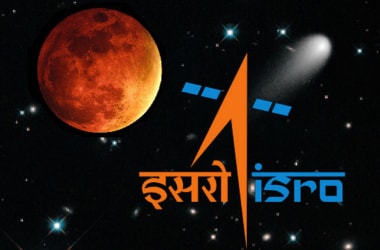 Indian Space Research Organisation has successfully realigned the orbit of its Mars Orbiter Mission 'Mangalyaan.' Indian Space Research Organisation has successfully realigned the orbit of its Mars Orbiter Mission 'Mangalyaan.'
The aim is to ensure that the study is not affected by long-duration eclipse.
The duration of the eclipse was so long that the Mangalyaan's battery capacity would have got exhausted due to lack of sun rays.
ISRO therefore, manoeuvred to change the orbit of Mangalyaan and reduced the duration of eclipse.
MOM still has 30kg fuel left, and with realignment it will work longer.
The correction in the trajectory of Mangalyaan was required to keep the power supply strong during the eclipse.
It is caused by shadow of Mars falling on it for 7-8 hours so that it could continue to function longer.
This is because Mangalyaan's battery cannot support long-duration eclipse.
Know More About Mangalyaan
- Name: Mangalyaan
- Mission type: Mars orbiter
- Operator: ISRO
- Website: www.isro.gov.in/pslv-c25-mars-orbiter-mission
- Manufacturer: ISAC
- Launch mass: 1,337.2 kg
- BOL mass: ˜550 kg
- Dry mass: 482.5 kg
- Payload mass: 13.4 kg
- Dimensions: 1.5 m (4.9 ft) cube
- Power: 840 watt
|
▼ Robot journalist Xiao Nan debuts in China [01-20-17]
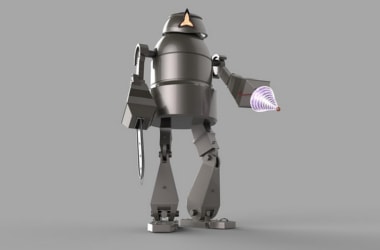 For the first time, a robot journalist made its debut. The robot wrote a 300 characters long article in just under a second, in a Chinese daily. For the first time, a robot journalist made its debut. The robot wrote a 300 characters long article in just under a second, in a Chinese daily.
The article was published in Guangzhou-based Southern Metropolis Daily. It was focused on the Spring Festival travel rush.
Author Xiao Nan took a single second to complete writing the peace and wrote both long and short stories.
The robot journalist developed by Peking University has stronger capacity for data analysis. It is quicker in writing stories.
Robot journalists will be able to supplement the role of editors and reporters in newspapers and related media however.
|
▼ MERS, Lassa Fever and Nipah Virus threaten mankind [01-20-17]
 Scientists have named three relatively little-known diseases, MERS (Middle East respiratory syndrome), Lassa fever and Nipah virus the next potential global health emergency threat. Scientists have named three relatively little-known diseases, MERS (Middle East respiratory syndrome), Lassa fever and Nipah virus the next potential global health emergency threat.
In this regard, the Coalition for Epidemic Preparedness Innovations (CEPI) has committed 460 million dollars to speed up vaccine development for the diseases.
CEPI aims to have 2 new experimental vaccines ready for each disease within 5 years in order to be prepared incase of their global outbreaks.
CEPI is a public-private coalition that aims to derail outbreaks of epidemics by speeding development of vaccines.
It is funded by the Wellcome Trust, Bill and Melinda Gates Foundation, World Economic Forum (WEF).
Other funders are Government of Norway and Department of Biotechnology, Ministry of S&T, Government of India.
What is MERS?
- Middle East respiratory syndrome (MERS) is a viral respiratory disease.
- It is caused by a novel coronavirus (MERS-CoV).
- It was first identified in Saudi Arabia in 2012.
- Typical MERS symptoms include fever, cough and shortness of breath.
- Pneumonia is common, but not always present.
- Gastrointestinal symptoms, including diarrhoea, have also been reported.
- Approximately 36% of reported patients with MERS have died (WHO, 2017).
|
▼ BNHS AI Platform Internet of Birds launched [01-19-17]
 Bombay Natural History Society (BNHS) has recently launched a one-of-its-kind , AI online platform that identifies Indian bird species. Bombay Natural History Society (BNHS) has recently launched a one-of-its-kind , AI online platform that identifies Indian bird species.
NGO has collaborated with Bangalore based tech firm Accenture to create online database of 300 species of avifauna in the nation.
This cloud-based platform, titled Internet of Birds, requires any amateur bird watcher to just upload picture of the bird.
It runs an analysis on the picture, compares it to the species in the database and informs the person of the bird species.
It also has an image recognition and deep learning mechanism.
This helps in identifying key species of birds.
Biodiversity in India: Avifauna
- India is a biodiversity hotspot.
- It is home to almost 12.5% of the world's avifauna.
- It is consisting of 1,300 species.
- This platform can identify over 300 species but will eventually support all species found in India.
- Birds are excellent indicators of their environment.
|
▼ Union HRD Ministry launches dedicated web portal ShaGun for SSA [01-19-17]
 Union HRD Ministry Slaunched a dedicated web portal ‘ShaGun’ for the Sarva Shiksha Abhiyan. Union HRD Ministry Slaunched a dedicated web portal ‘ShaGun’ for the Sarva Shiksha Abhiyan.
The portal was launched at New Delhi on 18th Jan 2017.
‘ShaGun’ tracks innovations and progress in Elementary Education sector of India.
Through continuous monitoring of the flagship scheme - Sarva Shiksha Abhiyan (SSA), it also aims to improve quality of education.
ShaGun, which has been coined from the words ‘Shala’ meaning Schools and ‘Gunvatta’ meaning Quality, has been developed with a twin track approach:
Repository with an engaging interface, positive stories and developments in the field of School Education.
Online monitoring module to measure state-level performance and progress against key educational indicators.
SSA a CSS is providing universal access to education to children in the age group of 6-14 years of age.
SSA ShaGun web portal can be accessed at http://ssashagun.nic.in.
|
▼ Scientists develop world's lightest mechanical watch RM 50-03 [01-18-17]
 Developing the world’s lightest high-performance mechanical watch RM 50-03, scientists used ‘wonder material’ graphene. Developing the world’s lightest high-performance mechanical watch RM 50-03, scientists used ‘wonder material’ graphene.
The RM 50-03 watch weighs just 40 gms.
The superlight watch was made using a unique grapheme composite known as Graph TPT.
It is incorporating graphene to manufacture a strong but lightweight new case to house the delicate watch mechanism.
It was jointly developed by the University of Manchester (UK), Richard Mille and McLaren F1.
Graph TPT weighs less than previous similar materials used in watchmaking.
Graphene is the world’s first 2D material at just one-atom thick.
It was first isolated in 2004 and has the potential to revolutionise applications including high-performance composites for the aerospace and automotive industries.
It is also used for flexible, bendable tablets, mobile phones and next-generation energy storage.
|
▼ Astronomers find 2 trillion galaxies in the universe [01-18-17]
 The universe contains around 2 trillion galaxies, ten times more than previously thought according to a new study. The universe contains around 2 trillion galaxies, ten times more than previously thought according to a new study.
Astronomers have sought to study how much the number of galaxies are in the observable universe equals.
Scientists have used images from Hubble Space Telescope to estimate that the universe contains 100-200 billion galaxies.
Presently, technology permits just 10 percent of these galaxies to be studied and remaining 90 percent will be seen once bigger and better telescopes are developed.
Pencil beam images of deep space from telescopes around the world, and especially from the Hubble telescope, were converted into 3D maps.
This permits the density of the galaxies as well as volume of one small region of space following another to be studied.
Like an intergalactic archaeological dig, the research has enabled the team to establish how many galaxies have been missed.
Results of the study are based on the measurement of number of observed galaxies at different epochs through the universe history.
The scientists have examined how many galaxies there were at a given epoch they found that were significantly more at earlier times.
When the universe was a few billion years old, there were 10 times as many galaxies in a given volume of space as there were within a similar volume in present times.
Most galaxies are low mass systems with masses similar to those of the satellite galaxies surrounding the Milky Way.
Over 13.7 billion years of cosmic evolution since the Big Bang saw galaxies that have been growing through star formation and merger with other galaxies.
This suggests significant evolution must have occurred to reduce their number through extensive merging of systems.
|
▼ TN government launches tourism mobile app Pinakin [01-17-17]
 Tamil Nadu government has launched a mobile application Pinakin. Tamil Nadu government has launched a mobile application Pinakin.
It will seek to provide information of famous tourist destinations in the state.
The app will provide data on other major tourist destinations in Tamil Nadu.
Initially, it will cover world heritage tourist sites like Thanjavur Big Temple, Gangaikonda Cholapuram, Mamallapuram and Darasuram.
The app will provide information in 2 languages Tamil and English, benefiting both domestic and global tourists.
The free audio guide, launched by TN Tourism Department. is first-of-its-kind initiative and other major spots would be covered in a phased manner.
On the Google Playstore, the app has been welcomed and had also been given a good rating as well.
Users have described it as very useful as it provides details which even a guide cannot.
With focus on providing audio content, the application keeps tourists engaged for close to two hours.
App users can listen to interesting stories, facts and trivia about the sites.
Along with this, the application also provides other information such as ticket prices, parking details and dress code.
TN Department of Tourism: Know More
- Tamil Nadu Tourism comprises Tourism Department in the Secretariat, and a Commissionerate of Tourism.
- It is functioning to formulate policies and implement programmes for the development of tourism sector in the State.
- Tamil Nadu Tourism Development Corporation is a state owned PSU.
- It works to initiate novel ventures and innovate new schemes for providing demonstration effect to the private sector.
- Tamil Nadu Tourism coordinates the activities of various other Government Departments / agencies and the private sector.
|
▼ MoES launches high resolution, global deterministic model for weather forecasts [01-17-17]
 Ministry of Earth Sciences has made a high resolution (12 km) global deterministic model for forecast generation of weather operational. Ministry of Earth Sciences has made a high resolution (12 km) global deterministic model for forecast generation of weather operational.
New model has now replaced the earlier version which had a horizontal resolution of 25 km.
The operational Ensemble Prediction System will also be upgraded to 12 km to overcome forecast uncertainties.
Multiple forecasts will now be generated with slight variations, helping to generate probabilistic forecasts and quantify the uncertainties.
The ministry provides weather, climate and hydrological services to various users round the year.
Both operational and research aspects for these services are implemented through various organizations namely:
- India Meteorological Department (IMD),
- National Centre for Medium Range Weather Forecasting (NCMRWF),
- Indian Institute of Tropical Meteorology (IITM) and
- Indian National Centre for Ocean Information System (INCOIS).
Research is on at IITM, NCMRWF and IMD on weather prediction model development and data assimilation methods. Data from international and Indian satellites are being assimilated in the weather prediction models. Besides, the IMD has established an effective mechanism for dissemination of weather and climate forecasts to different stakeholders using different communication channels. About IMD: Know More- Formed: 1875
- Jurisdiction: Government of India
- Headquarters: Mausam Bhavan, Lodhi Road, New Delhi
- Annual budget: ₹3.52 billion (US$52 million) (2011)
- DG: Dr. K.J. Ramesh
- Department: Ministry of Earth Sciences
- Website: www.imd.gov.in
|
▼ SEZ India: App for Special Economic Zones [01-16-17]
 A Mobile app named “SEZ India” has been launched by the Commerce Secretary, SEZ Division, Department of Commerce under its broader e-Governance initiative. A Mobile app named “SEZ India” has been launched by the Commerce Secretary, SEZ Division, Department of Commerce under its broader e-Governance initiative.
SEZ Online System, has developed mobile app for Special Economic Zones (SEZs).
Commerce Secretary launched the app and mentioned that the App would help the SEZ Units and Developers to find information easily and track their transactions on SEZ Online System.
SEZ Developers & Units can file all their transactions digitally through SEZ Online system and track the status on the go through the SEZ India mobile app.
The app is available on Android Platform for use by SEZ Developers, Units, officials and others.
Sections of App
The app has four sections
- SEZ Information: This is a compendium of the SEZ Act, 2005, SEZ Rules, 2006, MOCI Circulars, details of SEZs and Units etc. It gives up to date comprehensive details on all the above aspects.
- Trade Information: This provision gives access to important information / tools such as Foreign Trade Policy, Hand Book of procedure , Duty Calculator , Customs & Excise Notification and MEIS Rates.
- Contact Details: See all the contact details of all Development Commissioners Office, DGFT, DG System, DGCI & S and SEZ online.
- SEZ online Transaction This is a dynamic submenu that tracks the Bill of Entry / Shipping Bill processing status and also does verification.
The app also helps the Importers / Exporters to track the status of 'Bill of Entry / Shipping Bill” integration and processing in the EDI system of the ICEGATE.
|
▼ HySP : New 5D technique to analyse images [01-16-17]
 Scientists have developed a new 5D technique for analysing images. Scientists have developed a new 5D technique for analysing images.
This an advance that may make it easier to quickly find signs of diseases from pictures using cell phones.
It is known as "Hyper-Spectral Phasor" analysis, or HySP.
Through this, fluorescent imaging is used to locate proteins and other molecules in cells and tissues.
The technique works on using molecules with dyes that glow under certain kinds of light, the principle behind so-called "black light" images.
Fluorescent imaging can assist scientists to understand which molecules are produced in large amounts in cancer or other diseases.
The information that may be useful in diagnosis or in identifying possible targets for therapeutic drugs.
Biological research is now moving to complex systems like these, which track multiple targets.
HySP can look at many different molecules in one pass.
Additionally, the algorithm effectively filters through interference to discern the true signal, even if that signal is extremely weak.
Clinicians may be able to use HySP to analyze cell phone pictures of skin lesions to detect cancer and diagnose it.
Advantages
- It is much faster and far less expensive than current techniques.
- It may be useful for diagnosing.
- It also helps in monitoring diseases.
- It is convenient to use through cell phone images.
|
▼ E-waste rises by 63% in 5 years in Asia: UN report [01-16-17]
 Electronic waste or e-waste is rising sharply across Asia. Higher incomes allow millions of people to buy smartphones and other gadgets with serious problems for human health and the environment. Electronic waste or e-waste is rising sharply across Asia. Higher incomes allow millions of people to buy smartphones and other gadgets with serious problems for human health and the environment.
The UN study has found e-waste in Asia has jumped 63 percent in 5 years. A report by the United Nations University also warned of the need to improving recycling and disposal methods.
Many countries lack infrastructure for eco-friendly e-waste management. Increasing volumes are a cause for concern, according to the UN University's Sustainable Cycles Programme.
China and other nations in Asia are dumping grounds for e-waste from developed nations. The Asian nations recycle the waste in unsafe but ultra cheap backyard factories.
Asia has emerged as a source of increasing e-waste with affluent customers also buying items such as phones, tablets, personal computers and TVs.
China alone has doubled its generation of e-waste between 2010 and 2015 according to the report.
Per capita, the worst economy in the region is Hong Kong. Each person in this Chinese region generates 21.7 kg or 47.8 pounds of e-waste in 2015.
Singapore and Taiwan are also leading in e-waste, with 19 kg per person generated in 2015.
The lowest e-waste generators were Vietnam, Philippines and Cambodia. These nations averaged 1 kg of electronic waste per person.
Fighting illegal dumping is a must. Improper e-waste generates toxic chemicals which cause severe health and environmental consequences.
Acids to separate metals in e-waste are dangerous and this exposure can lead to serious health problems.
For example, a Chinese town Guiyu which build its economy on overseas e-waste recycling is facing toxic water and air contamination. High lead levels are found in the blood of the residents.
Electronic remnants were also strewn in the stream and led to danger in terms of contaminating the water supply.
People's Republic of China's Government: Know More
- Government: Unitary Communist state
- Party General Secretary and President: Xi Jinping
- Premier: Li Keqiang
- Congress Chairman: Zhang Dejiang
- Conference Chairman: Yu Zhengsheng
- First-ranked Secretary of the Secretariat: Liu Yunshan
- Secretary of Discipline Inspection Commission: Wang Qishan
- First Vice Premier: Zhang Gaoli
|
▼ Silicon likely to be the mystery element in earth's inner core! [01-13-17]
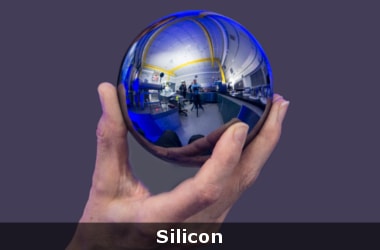 Japanese scientists have said that silicon is likely to be the mystery element in the inner core of the earth. This could solve one of the biggest secrets of the planet. Japanese scientists have said that silicon is likely to be the mystery element in the inner core of the earth. This could solve one of the biggest secrets of the planet.
Consensus has long been that centre of the planet comprises:
- Iron-85%
- Nickel-10%
- Sulphur, Oxygen and Silicon-5%
But Japanese scientists have found that iron nickel alloys mixed with silicon were able to sustain pressure and temperature found in the inner core of the earth. Data for the mixed material observed with X-rays matched seismic data namely sound velocity, or seismic waves obtained for the inner core. Finding could reveal if earth was rich in oxygen before photosynthesis. Oxygen has been listed as another potential candidate for mystery element in the inner core. About the Layers of the Earth- Earth is composed of three main layers: outer layer, mantle and core.
- Outer layer is solid where creatures reside.
- Mantle is composed of hot magma and other semi solid materials.
- Core is composed of outer layer of liquid iron and nickel and inner layer - a hot dense ball of mostly iron.
|
▼ Paperfuge: Paper made human powered blood centrifuge [01-13-17]
 Engineering scientists at Stanford University have build an ultra-low cost human powered blood centrifuge separating blood into individual components in 1.5 minutes. Engineering scientists at Stanford University have build an ultra-low cost human powered blood centrifuge separating blood into individual components in 1.5 minutes.
It is created from 20 cents of twine, paper and plastic and is called a paperfuge.
It can spin at speeds of 1,25,000 revolutions per minute and exert centrifugal forces of 30 thousand Gs.
It is the fastest spinning object driven by human power. It has the potential to enable precise diagnosis and treatment of diseases such as malaria, HIV and TB.
|
▼ Now, a smartphone you can wrap around your wrist! [01-13-17]
 A US-based company has developed a smartphone prototype that can be rolled up around the wrist. A US-based company has developed a smartphone prototype that can be rolled up around the wrist.
To receive a call, it can either be used as a speaker or removed and straightened into a traditional phone.
At the end of the call, you may bend it back onto your wrist.
FlexPhone, developed by US-based Royole Corporation, can also function as a fitness tracker.
It monitors your physical parameters, including heart rate, the number of steps taken, and the distance travelled.
The phone is 6 millimetres thick and weighs 100 grams.
Phone's display as well as circuitry are flexible, making it sturdy in handling drops and bumps.
The phone features 3G connectivity, and is SIM-card compatible.
It was named the innovation awards honoree at the CES trade show in Las Vegas, US.
|
▼ Pluto's moon Charon protects its atmosphere from decay [01-13-17]
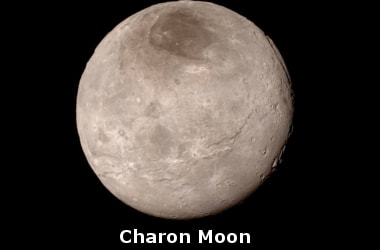 Pluto's moon Charon which is half its diameter and orbits 12,000 miles away, is slowing down the decay of Pluto's atmosphere. Pluto's moon Charon which is half its diameter and orbits 12,000 miles away, is slowing down the decay of Pluto's atmosphere.
This moon protects the continuous stripping of Pluto's atmosphere by the solar wind.
Charon is between Pluto and the Sun, and it can reduce atmospheric loss significantly.
Though the moon does not have its own atmosphere, it does create a shield for Pluto and redirects solar wind around and away.
Barrier creates an acute angle of Pluto's bow shock, slowing down the deteriorating atmosphere's rate of decay.
This barrier creates a more acute angle of Pluto's bow shock, slowing down the deterioration of the atmosphere.
The study's predictions, before the New Horizons probe collected and returned data to Earth, matches measurements made it about about Pluto's atmospheric loss rate.
|
▼ Robots to assist you with banking at HDFC! [01-11-17]
 HDFC launched ‘IRA’ (or Intelligent Robotic Assistant), a humanoid, which will provide assistance services in bank branches. HDFC launched ‘IRA’ (or Intelligent Robotic Assistant), a humanoid, which will provide assistance services in bank branches.
The robot will be unveiled at one of its bank branches in the next 10-12 days. The bank will take a decision on deploying additional robots in branches.
In the initial phase, it will be deployed in branches. It will be a mobile robot which will be capable of offering services while being in motion.
Block-chain, artificial intelligence and Internet of Things will also be looked into in the future to offer products and services in this domain.
Kochi-based ASIMOV Robotics has helped the bank with the robot creation. This company is a single window solution and services provider that aims to meet all robotics/automation needs.
Through the Digital Innovation Summit, HDFC is also inviting ideas from startups and fintech companies in the areas of Internet of Things, virtual reality, block-chain, rural fin-tech, among others.
The top five ideas selected will be evaluated to give the respective companies an opportunity to partner with HDFC Bank.
City Union Bank had launched its humanoid Lakshmi which was an artificial intelligence powered robot.
This robot was able to speak English, gesture and engage in a life-like manner in conversations.
It was enabled to interact with customers on segments like account balance and interest rates on loans.
|
▼ Mumbai WiFi - Largest public WiFi service in India [01-11-17]
 Maharashtra Chief Minister Devendra Fadnavis on Jan 9, 2017 announced the largest public Wi-Fi service in Mumbai with 500 Wi-Fi live hotspots across the city. Maharashtra Chief Minister Devendra Fadnavis on Jan 9, 2017 announced the largest public Wi-Fi service in Mumbai with 500 Wi-Fi live hotspots across the city.
500 WiFi Hotspots go live across various locations in Mumbai.
MumbaiWifi is India’s largest Public WiFi service and one of the largest globally too.
1,200 Wi-Fi hotspots will go live in Mumbai by May 1, as committed. Connectivity and speed will be monitored.
Another 700 hotspots will be active by May 1 - which is celebrated as Maharashtra Day.
During the trial period between January 2-8, around 23,000 users signed up in Mumbai and downloaded more than 2TB (TetraByte) data.
The Wi-Fi - free with unlimited usage till January 31 - is now available at the offices of Mumbai Police Commissioner, Vidhan Bhavan, KalaNagar in Bandra, Bombay High Court among others.
Maharashtra Information Technology Corporation (MITC) has collaborated with US-based companies like Hewlett Packard and Fortinet for this service.
Mahanagar Telephone Nigam Ltd is the bandwidth provider and Larsen & Toubro is the systems integrator.
Public Wi-Fi era is also there in Mumbai hotspots at certain important railway stations for commuters.
Some private locations like malls, cinemas, restaurants, hotels offered limited free Wi-Fi access to their patrons.
|
▼ Kuaizhou-1A rocket with three satellites - First Chinese commercial mission [01-11-17]
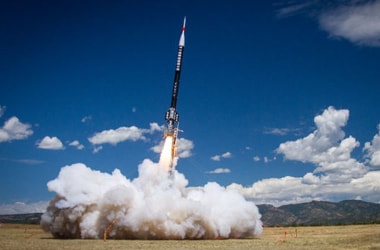 China on 9th Jan 2017 sent three satellites into space in its first commercial mission using an updated version of the low-cost Kuaizhou-1A rocket. China on 9th Jan 2017 sent three satellites into space in its first commercial mission using an updated version of the low-cost Kuaizhou-1A rocket.
The rocket carried the satellite JL-1 and two CubeSats XY-S1 and Caton-1.
It blasted off from northwestern China’s Jiuquan Satellite Launch Center in Gansu province at around 12:11 pm local time.
KZ-IA rocket was developed from the Kuaizhou-1 rocket programme with improvements in adaptability.
A low-cost solid- fuelled carrier rocket with high reliability and short preparation period, it was designed to launch low-orbit satellites weighing under 300 kg.
A rocket technology company under the China Aerospace Science and Industry Corporation was responsible for the launch mission.
China plans to conduct a record number of 30 space launch missions this year.
The record-breaking space launches will be launched by Long March-5 and Long March-7 rockets.
Long March-5 is China’s largest carrier rocket.
China conducted 22 launch missions in 2016 and 19 in 2015.
The country successfully tested its Long March-7 rocket in June 2016.
China plans to provide space and aviation-related services to countries involved in its ‘One Belt and One Road’ initiative.
About the Three Satellites
JL-1
- Multifunctional remote-sensing satellite.
- It is providing high-definition video images
- It expected to be used for land resource and forestry surveying, environmental protection, transport and disaster prevention and relief purposes.
XY-SI and Caton-1
- Experimental satellites to test technologies.
- Characterised by low-orbit narrow-band communication and VHF Data Exchange System (VDES) respectively.
|
▼ ISRO-CNES agreement on satellite launch technology signed [01-11-17]
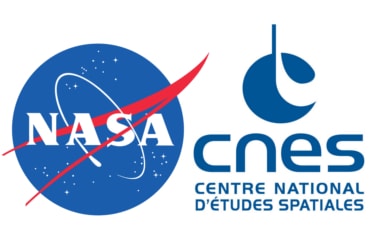 Indian Space Research Organisation and French space agency CNES signed a partnership agreement in satellite launch technology on 10th Jan 2017. Indian Space Research Organisation and French space agency CNES signed a partnership agreement in satellite launch technology on 10th Jan 2017.
Agreement was signed between ISRO Chairman Kiran Kumar and CNES President Jean-Yves Le Gall.
Space cooperation between France and India spans 50 years and is a cornerstone of the Indo-French strategic partnership.
ISTRAC (ISRO Telemetry Tracking and Command Network) monitors Indian space missions, including the two Indo-French satellites currently in orbit for collecting data to track climate change.
ISRO is the second partner of CNES, in terms of volume, after NASA.
Of comparable size and sharing similar objectives, the space programmes of both countries are complementary.
Through the partnership, France to benefit from the Indian model of streamlining the costs of space programmes.
As TeamIndus races to design an all-terrain rover by end-2017 for this lunar mission, CNES will provide it with cameras.
An agreement was signed providingAxiom Research Lab's lunar rover with two latest-generation CASPEX micro-cameras.
These are developed by CNES in partnership with French firm 3DPlus.
In joining forces with Team Indus on this first private mission to land a rover on the moon, CNES is sending French technology for the first time on lunar terrain.
About CNES
- The Centre national d'études spatiales is the French government space agency.
- Its headquarters are located in central Paris.
- It t is under the supervision of the French Ministries of Defence and Research.
- Budget: 2.126 billion EUR (2015)
- Headquarters: Paris
- Founder: Charles de Gaulle
- Founded: 19 December 1961
|
▼ Retroviruses like HIV may be half a billion years old [01-11-17]
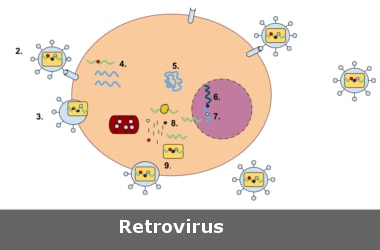 Retroviruses, a family of viruses that include HIV are half a billion years old, according to scientists. Retroviruses, a family of viruses that include HIV are half a billion years old, according to scientists.
New research indicated retroviruses have ancient marine origins. They have been with animal hosts through the revolutionary transition from sea to land.
Up till now, it was believed these viruses were just 100 million years in age. Research shows retroviruses are 450 million years old and possibly older.
They may have originated with veterbrate hosts in the early Paleozoic era.
Present in vertebrate ancestors before land colonisation, they have accompanied hosts through transition from sea to land.
What are Retroviruses?
- A genre of viruses that cause chronic diseases like AIDS, cancer and autoimmune disorders.
- The 'retro' part of their name comes from the fact they are made of RNA.
- RNA is converted into DNA and inserted into their host genome.
- Genomic fossils for foamy-like retroviruses were found in highly diverse hosts.
- These are including ray-finned fish and amphibians.
|
▼ Babur 3: Nuclear warhead compatible cruise missile launched [01-10-17]
 Pakistan on 9th Jan 2016 launched its first submarine launched cruise missile capable of carrying nuclear warheads up to 450 kms called Babur-3. Pakistan on 9th Jan 2016 launched its first submarine launched cruise missile capable of carrying nuclear warheads up to 450 kms called Babur-3.
It gives Pakistan credible second strike capability. The missile was fired from an underwater, mobile platform.
It is the sea based variant of Ground Launched Cruise Missile (GLCM) Babur-2, which was successfully tested earlier in December, 2016.
Babur-3 SLCM incorporated state of the art technologies including underwater controlled propulsion and advanced guidance and navigation features.
It can evade hostile radars and air defenses. In land attack mode, it can deliver numerous types of payloads.
Know More On Babur cruise missile/Hatf VII
- Type: Medium-range subsonic cruise missile
- Place of origin: Pakistan
- Manufacturer: National Defence Complex (NDC)
- Weight : <1,500 kg (payload >300 kg)
- Length: 6.25 m (7 m with booster)
- Diameter: 0.52 m
- Warhead: Conventional or nuclear
- Engine : Turbofan
- Wingspan: 2.67 m
- Propellant: Solid fuel (booster rocket); Liquid fuel (jet engine)
- Operational range: 700 km
- Speed: 880 km/h or 550 mph (Mach 0.8)
|
▼ Two most powerful universe phenomena discovered by GMRT [01-9-17]
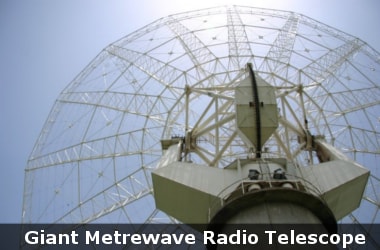 Astronomers, using data from India’s Giant Metrewave Radio Telescope (GMRT), have discovered two of the most powerful phenomena in the universe – a supermassive black hole and the collision of giant galaxy clusters about two billion light years from Earth. Astronomers, using data from India’s Giant Metrewave Radio Telescope (GMRT), have discovered two of the most powerful phenomena in the universe – a supermassive black hole and the collision of giant galaxy clusters about two billion light years from Earth.
The two phenomenon have combined to create a stupendous cosmic particle accelerator, researchers said and they found what takes place when matter ejected by a giant black hole is swept up in the merger of two enormous galaxy clusters.
This is the first time, however, that we see them clearly linked together in the same system and the cosmic double whammy is found in a pair of colliding galaxy clusters called Abell 3411 and Abell 3412 located about 2 billion light years from Earth.
The two clusters are both very massive, each weighing about a quadrillion - or a million billion - times the mass of the Sun.
The powerful electromagnetic fields associated with this structure have accelerated some of the inflowing gas away from the vicinity of the black hole in the form of an energetic, high-speed jet.
These accelerated particles in the jet were accelerated again when they encountered colossal shock waves – cosmic versions of sonic booms generated by supersonic aircraft -produced by the collision of the massive gas clouds associated with the galaxy clusters.
This discovery solves a long-standing mystery in galaxy cluster research about the origin of beautiful swirls of radio emission stretching for millions of light years, detected in Abell 3411 and Abell 3412 with the GMRT.
The galaxy clusters are known as Abell 3411 and Abell 3412, which are located about two billion light years from Earth.
Based on data obtained from the Chandra X-ray Observatory, the Giant Metrewave Radio Telescope (GMRT) in India, the Karl G. Jansky Very Large Array, the Keck Observatory, and Japan’s Subaru Telescope, the team was able to capture this event.
It was captured in the optical, x-ray, and radio wave wavelengths.
|
▼ MIT researchers develop 3D graphene [01-9-17]
 Researchers from the Massachusetts Institute of Technology (MIT) have developed 3D version of graphene by compressing and fusing flakes of graphene, a two-dimensional form of carbon. Researchers from the Massachusetts Institute of Technology (MIT) have developed 3D version of graphene by compressing and fusing flakes of graphene, a two-dimensional form of carbon.
Graphene is one of the strongest materials known to man, but so far because of its extreme thinness it was not able for practical use.
The 3D version of Graphene was produced using a combination of heat and pressure.
It produced stable structures called diatom.
This version is lightweight, only percent as dense as steel but is 10 times stronger.
This novel development could lead production of lighter, stronger materials.
|
▼ NASA builds road maps for Voyager spacecrafts [01-9-17]
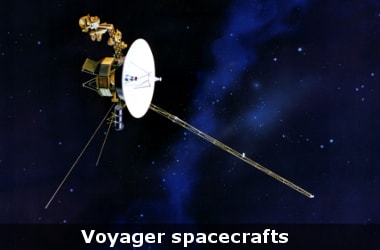 NASA's Hubble Space Telescope is set to create a roadmap for two Voyager spacecrafts that will travel through unexplored territories beyond the solar system, by measuring the material along the future trajectories of the probe. NASA's Hubble Space Telescope is set to create a roadmap for two Voyager spacecrafts that will travel through unexplored territories beyond the solar system, by measuring the material along the future trajectories of the probe.
When Voyagers run out of power and are unable to send back new data, Hubble will still be able to tap them to learn more about their environment.
A preliminary analysis of the Hubble observations shows a rich, complex interstellar ecology, containing multiple clouds of hydrogen laced with other elements.
This also provides new data into how the sun travels through interstellar space.
This is a great opportunity to compare data from in situ measurements of the space environment by the Voyager spacecraft and telescopic measurements by Hubble.
The astronomers hope that the Hubble observations will help them characterise the physical properties of the local interstellar medium. Synthesising these insights with in situ measurements from Voyager would provide an unprecedented overview of the local interstellar environment.
For the next 10 years, the Voyagers will be making measurements of interstellar material, magnetic fields and cosmic rays along their trajectories.
About Voyager Spacecrafts
- NASA launched the win Voyager 1 and 2 spacecrafts in 1977.
- Both explored outer plants Jupiter and Saturn.
- Voyager 2 went on to visit Uranus and Neptune.
- The spacecrafts are currently exploring the outermost edge of the Sun's domain.
- Voyager 1 is zooming through interstellar space, between stars filled with gas, dust and recycled material from dying stars.
- The probe is 13 million miles from earth– this is the farthest human made object ever build.
- In 40 thousand years, the spacecraft will no longer be able to father new data and will pass within 1.6 light-years of the star Gliese 445, in the constellation Camelopardalis.
- Its twin, Voyager 2, is 10.5 billion miles from Earth, and will pass 1.7 light-years from the star Ross 248 in about 40 thousand years.
|
▼ China to set up world's highest altitude gravitational wave telescope [01-9-17]
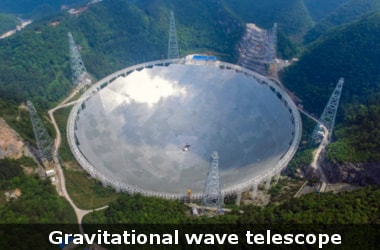 China is setting up the world's highest altitude gravitational wave telescopes in Tibet, close to the Line of Actual Control with India. China is setting up the world's highest altitude gravitational wave telescopes in Tibet, close to the Line of Actual Control with India.
The telescopes are being set up with a budget of USD 18.8 million to detect the faintest echoes resonating from the universe which may reveal more about the Big Bang theory.
Construction has started for the first telescope codenamed Ngari No 1, 30 km south of Shiquanhe Town in Ngari Prefecture.
Parts of Nagri are in the last Tibetan prefecture at China's border with India. The telescope located 5250 m above sea level, will gather accurate data on the primordial gravitational waves in the Northern Hemisphere.
It will be operational by 2021. The 2nd phase involves a series of telescopes, code-named Ngari No 2, to be located about 6,000 meters above sea level.
Construction for the two phase Ngari gravitational wave observatory is 130 million yuan. The project has been initiated by Institute of High Energy Physics, National Astronomical Observatories and Shanghai Institute of Microsystems and Information Technology, along with others.
Ngari with a high attitude, clear sky and minimal human activity is said to be the world's best spot to detect twists in cosmic light.
It will be among the world's top primordial gravitational wave observation bases.
G-Waves: Know More
- The top gravitational wave observation bases currently include the South Pole Telescope and the telescope at Chile's Atacama Desert.
- Gravitational waves (G-waves) were first proposed by Albert Einstein's theory of general relativity.
- This theory was discovered 100 years ago.
- It was in 2016 that LIGO (Laser Interferometer Gravitational Wave) Observatory announced the proof of the wave existence, spurring fresh research among world scientists.
- In September 2016, China commissioned the world's largest radio telescope to understand more about the universe and the possibility of alien life.
- The telescope's main structure is a reflector as large as 30 football pitches built in the unique valley at Guizhou.
|
▼ Israel to get world's tallest solar tower [01-9-17]
 Israel is constructing the world's tallest solar tower to harness solar energy. This is part of its Ashalim project, located in the Negev desert. Israel is constructing the world's tallest solar tower to harness solar energy. This is part of its Ashalim project, located in the Negev desert.
The centre of the Ashalim solar tower, it will be 250 metres tall and will be encircled by 50 thousand mirrors called heliostats.
Solar towers use different method conventional photovoltaic solar panels. These convert sunlight directly into electricity. The solar towers use solar thermal method in which 1000s of mirrors focus the sun's rays into the tower, heating the boiler that creates steam to spin the turbine and generate electricity.
Ashalim project is made up of three fields each with a different solar technology. Together, these solar fields will be Israel’s largest renewable energy project after completion by 2018.
They will generate some 310 MW of power that is, about 1.6% of the Israel’s energy needs enough for about 130,000 households, or roughly 5% of Israel’s population.
|
▼ World's first completely wireless laptop: Dell Latitude 7285 [01-9-17]
 WiTricity announced that Dell's Latitude 7285 will incorporate its wireless charging technology to become the industry's first two-in-one to able workplace free of wires to the device. WiTricity announced that Dell's Latitude 7285 will incorporate its wireless charging technology to become the industry's first two-in-one to able workplace free of wires to the device.
It includes the company's magnetic resonance based wireless charging for PCs.
Latitude 7285 is an AirFuel certified system which will be interoperable with emerging magnetic resonance based wireless charging ecosystem, in which WiTricity technology is foundational.
The new Latitude 7285 enables a streamlined user experience by allowing people to ditch cords to the device and have seamless charging for laptops when placed on AirFuel-certified compatible charging surface.
The Dell Latitude 7285 not only enables a more productive working environment, but accelerates establishment of a broader magnetic resonance-powered wireless charging ecosystem for a wide range of devices.
The trick lies in the keyboard with the Latitude 7285 is a 2-in-1 hybrid– 100% of its components fit inside the tablet display which catch to one of the three keyboards to create clamshell laptop.
The keyboard communicates with new wireless charging pad. The Latitude is positioned to compete with other 2-in-1s, such as the Microsoft Surface and the Lenovo Flex.
Available in 2017, it uses wireless power transfer over distance using magnetic resonance.
|
▼ Lucy and Psyche - New asteroid missions from NASA [01-9-17]
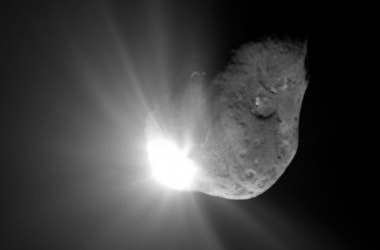 NASA has announced that it will provide complete funding under the Discovery Program for two missions focusing on different kinds of asteroids. NASA has announced that it will provide complete funding under the Discovery Program for two missions focusing on different kinds of asteroids.
A mission called Lucy will take off in 2021 to study a plethora of asteroids, including one in the main asteroid belt between Mars and Jupiter, along with size others among space rocks in Jupiter's orbit.
A mission Psyche will be launched in 2023 to visit a type of asteroid never seen closely before - a huge metallic object called 16Psyche that corresponds in composition to the core of the earth.
NASA will also provide funding for the Near Earth Object Camera designed to look for potentially hazardous asteroids in the region of space closest to the orbit of the earth.
Discovery Program missions are low-cost space science efforts, capped at USD 450 million. Before, selected discovery missions included:
- Messenger probe to Mercury
- Dawn probe to the asteroids Vesta and Ceres
InSight lander, which is due to begin its trip to Mars next year. Lucy, Psyche and NEOCam were among the finalists for this year. Two missions to Venus– DAVINCI and VERITAS– lost out on the round, but could be reconsidered in the future. Psyche MissionThis mission aims to explore one of a kind metal asteroid 16Psyche. It will be launched in 2023. Most steroids are rocky or covered in ice. 16Psyche is thought to be composed of nickel and iron, much like the core of the earth. This is a one of a kind object in the main asteroid belt. 16Psyche is a 130 mile wide chunk of material thought to be composed of metallic iron and nickel, and could be the exposed core of a Mars sized planet which lost its outer layer in collisions billions of years ago. Mission schedule calls for launch in Oct 2023, earth gravity assist manouver in 2024, a Mars FlyBy in 2025 and arrival at the asteroid in 2023. The probe will study the asteroid's composition, mass distribution and magnetic field over a two year period. 16Psyche is the only known object of its kind in the solar system and the only way humans will visit a core. Psyche also intrigues asteroid miners because the composition of the metal bearing space object could pave the way for other resources. LucyLucy mission has been named after a famous, critical hominin fossil found in Ethiopia in 1974. It will be launched in 2021 and involves sending robotic spacecrafts to study Jupiter's trojan asteroids. These asteroids are believed to be relics of an earlier era in the history of the solar system. Lucy is due for launch in Oct 2021 and will reach the first destination in the main belt in 2025. The problem will study six Jupiter Trojan asteroids between 2027 and 2033. Trojans are thought to be remnants of the early solar system that were gravitationally captured at balance points in the orbit of Jupiter. The small bodies are fossils of planet formation and that is Lucy has been named after a fossil. Lucy's target in the main asteroid belt is Donaldjohanson, in memory of the paeleontologist who discovered the famous 3.2 million year old fossil in 1974. Other targets include Trojan asteroid Eurybates, and the binary trojan Patroclus-Menoetius. Discovery Program Missions: Know More- Both the asteroid missions will unravel the origin and evolution of the solar system.
- This puzzle will understand how the sun and its family of planets changed over time and where life could be developed and sustained.
Five proposals were selected initially for this mission, including the following: i. Deep Atmosphere Venus Investigation of Noble gases, Chemistry, and Imaging (DAVINCI), ii. Venus Emissivity, Radio Science, InSAR, Topography, and Spectroscopy mission (VERITAS). iii. Near Earth Object Camera was another project proposed; it has been granted an extra year of funding. iv. NASA will not be observing bodies with atmospheres.
|
▼ Heal wounds without scars [01-9-17]
 In a massive breakthrough, researchers have a found a way to manipulate wounds to heal as regenerated skin, rather than scar tissue. In a massive breakthrough, researchers have a found a way to manipulate wounds to heal as regenerated skin, rather than scar tissue.
By transforming the most common type of cells found in wounds into fat cells, scientists have carried out a breakthrough.
Fat cells called adipocytes are generally found in the skin, but they are lost when wounds heal following scarring.
The most common cells found in healing wounds are myofibroblasts thought to form only a scar. Scar tissue lacks hair follicles which is another factor that grants it an abnormal appearance from the remainder of the skin.
Researchers at US University of Pennsylvania based their work on changing the myofibroblasts into fat cells that are not associated with scarring.
The wound healing can be manipulated so it leads to skin regeneration rather than scarring. The aim is to regenerate hair follicles before. Once that occurs, the fat will regenerate in response to signals from these follicles.
The study has also shown hair and fat may develop separately, but not independently. Hair follicles form first. Additional factors are produced by the regenerating hair follicle to convert the surrounding myofibroblasts to regenerate as fat instead of forming a scar.
The fat will not form in the absence of new hair, but once it does, the new cells cannot be distinguished from the pre-existing fat cells. This gives the wound a natural look while healing, instead of leaving a scar.
Researchers identified a BMP or Bone Morphogenetic Protein that instructs myofibroblasts to become fat. This signaling forms the basis of the breakthrough.
Myofibroblasts were initially thought to be incapable of becoming a different type of cell. But the work of these scientists shows that we have the ability to influence these cells and they can be efficiently and stably converted to fat cells.
Adipocyte cells are lost naturally because of the aging process, especially in the face which leads to permanent, deep wrinkles. Anti-aging treatment cannot fix this in a satisfactory way.
|
▼ First NASA astronaut of African-American origin to reach ISS [01-6-17]
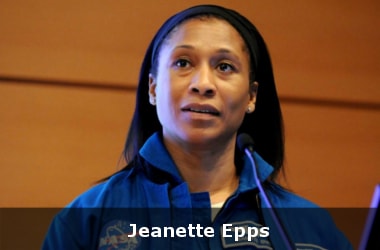 Female NASA astronaut Jeanette Epps is set to become the first African-American crew member aboard the International Space Station (ISS) when she flies to the orbital post in May 2018. NASA assigned veteran Andrew Feustel and Epps to missions aboard the ISS in 2018. Female NASA astronaut Jeanette Epps is set to become the first African-American crew member aboard the International Space Station (ISS) when she flies to the orbital post in May 2018. NASA assigned veteran Andrew Feustel and Epps to missions aboard the ISS in 2018.
Feustel will launch in March 2018 for his first long-duration mission, serving as a flight engineer on Expedition 55 and later as commander of Expedition 56. Epps will join Feustel as a flight engineer on Expedition 56 and remain on board for Expedition 57.
Epps received a bachelor’s degree in physics in 1992 at LeMoyne College in her hometown of Syracuse, New York. She then completed a master’s of science in 1994. She received a doctorate in 2000 in aerospace engineering from the University of Maryland.
Epps was a NASA Graduate Student Researchers Project fellow, authoring several journal and conference articles on her research. She went on to work in a research laboratory for more than two years, co-authoring several patents, before being recruited by the US Central Intelligence Agency.
She spent 7 years as a CIA technical intelligence officer before being selected as a member of the 2009 astronaut class.
|
▼ New human organ mesentery found in the digestive system [01-6-17]
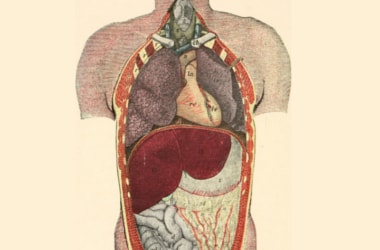 Scientists have discovered what is known as a new human organ in the digestive system. It is called mesentery. Scientists have discovered what is known as a new human organ in the digestive system. It is called mesentery.
The organ was previously believed to consist of fragmented and disparate structures. Researchers found, however, that it is one continuous organ and outlined evidence to classify it as such in a review published recently.
J. Calvin Coffey a researcher from University Hospital Limerick in Ireland who first made the discovery has said they have an organ in the body which has not been acknowledged to date.
Coffey, a professor at the University of Limerick, reclassified the mesentery after discovering it was contiguous. His findings were published in November in the medical journal The Lancet Gastroenterology and Hepatology.
Whether the mesentery should be viewed as part of the intestinal, vascular, endocrine, cardiovascular or immunological systems is so far unclear as it has important roles in all of them.
Mesentery research goes back to the time of Leonardo DaVinci, who provided one of the earliest depictions of the mesentery, which was shown as contiguous.
For centuries, the new-organ was depicted that way until the findings of Treves in 1885. His description of the mesentery - which was disconnected - became the basis of medical literature.
About the Mesentery
- It is a double fold of peritoneum, the lining of the cavity in the abs.
- It connects the intestine to the abdomen.
- Mesentery plays a central position in the body.
- Among its functions, it carries blood and lymphatic fluid between the intestine and the rest of the body.
- It also maintains the position of the intestine.
- It ensures that it’s connected with the abdominal wall without being in direct contact.
- It has a spiral formation in the abdomen.
- It is packaged along a spinal trajectory, starting in the upper abdomen and ending in the pelvis.
|
▼ Shangri-la of the World - Longest bullet train by China [01-6-17]
 China on 5th Jan 2016 launched its longest bullet train, “Shangi-la of the World” from Kunming, capital of South West China's Yunnan province to Beijing. China on 5th Jan 2016 launched its longest bullet train, “Shangi-la of the World” from Kunming, capital of South West China's Yunnan province to Beijing.
It is expanding its high speed train network to about 20,000 km connecting almost all provinces. The train left Kunming on a 2,670 km trip to Beijing which takes about 13 hours.
The train highlights the internationally famous resort in Shangri-la in Yunnan. The name first appeared in British novelist James Hilton's “Lost Horizon”.
This line is also the longest east-west high speed railway in China. A longer rail line stretching north to south is the 2298 Beijing-Guangzhou line, starting operations from 2012.
A white paper, titled “Development of China’s Transport,” said China would increase the length of high-speed railways in service to 30,000 km from the present 20000 kms by 2020 linking more than 80% of its big cities.
China's High Speed Rail: Know More
- China has built more than 20,000 km of high-speed rail lines.
- Mileage will be 45,000 km by 2030
- According to the government’s plan, the mileage will increase to 45,000 km by 2030.
- China has launched the Shanghai-Kunming line giving shape to the high speed rail grid connecting almost all provinces on the Chinese mainland.
- China is marketing its bullet train technology to many nations including India, competing with Japan.
- It aims to build a comprehensive transport system by 2020.
|
▼ Tuticorin based plant makes baking soda from Carbon dioxide! [01-4-17]
 A breakthrough make useful products out of planet-heating CO2 emissions has been attained. A breakthrough make useful products out of planet-heating CO2 emissions has been attained.
A plant at the S. Indian industrial port of Tuticorin is capturing CO2 from its own coal-powered boiler.
It is using it to make soda ash or baking powder.
The technology is running without subsidy which is a major advancement for carbon capture technology.
Firm says chemicals will lock up to 60 thousand tonnes of CO2 per year.
Tuticorin plant is the first industrial scale example of CCU/carbon capture and utilisation.
This expands the market for CO2 as a chemical raw material.
Stripping CO2 from low concentrations in flue gas was tough.
Indian plant called Tuticorin Alkali Chemicals uses a new CO2 stripping chemical developed by IIT investors at Carbonclean.
Less energy is required for this carbon capture technology which is less corrossive and requires smaller equipment.
The soda ash is a base chemical with a wide range of uses including glass manufacture, sweeteners, detergents and paper products.
Carbonclean believes capturing usable CO2 can deal with perhaps 5-10% of the world’s emissions from coal.
By producing a subsidy-free carbon utilisation project, Carbonclean has made rapid strides in CCU technology.
|
▼ Lefamulin: Drug molecule that combats antibiotic resistant pathogens [01-4-17]
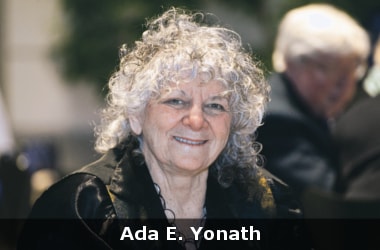 Researchers from Israel headed by Nobel laureate Ada E. Yonath is set to develop an effective drug to fight disease resistant pathogens, Researchers from Israel headed by Nobel laureate Ada E. Yonath is set to develop an effective drug to fight disease resistant pathogens,
The genetic solution to the menace of antibiotic resistance to a plethora of diseases such as TB and hospital acquired infections, it targets a bacteria called methicillin-resistant Staphylococcus aureus (MRSA).
Pathogens developing resistance to antibiotics are a real threat.
The novel molecule called Lefamulin has been found to treat diseases resistant to set of antibiotics.
This drug targets pneumonia.
Staphylococcus aureus is fast developing resistance.
This is causing new infections to patients.
Role of ribosomes to develop new generation antibiotics is being highlighted.
What are Antibiotics Drugs?
Antibiotics and similar drugs, together are called antimicrobial agents.
They have been used for the last 70 years to treat patients who have infectious diseases.
Since the 1940s, these drugs have greatly reduced illness and death from infectious diseases.
But, with the rise of antimicrobial resistance, the drugs are losing their impact.
|
▼ Know all about the Agni IV [01-3-17]
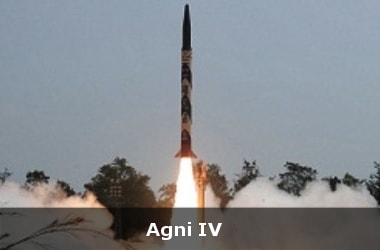 Agni-IV was launched on 2nd Jan 2016. This comes after India tested Agni-V the country's longest Agni-IV was launched on 2nd Jan 2016. This comes after India tested Agni-V the country's longest
range nuclear capable missile.
India has a series of nuclear-capable missiles like Prithvi series, Agni series and the Submarine Launched Ballistic Missile.
Agni-IV is a nuclear-capable missile with a range of 4,000 km while Agni-V has a range of 5,000 km.
Both missiles can cover most parts of China.
Agni-IV missile is 20m tall and weighs 17 tons.
It was launched from the integrated test range at Abdul Kalam Island or Wheeler Island.
This was the sixth trial of the Agni-IV missile.
The previous test was conducted on Nov 9 2015.
The fire and forget missile is navigated using a jam proof ring laser gyroscope. This enables avioncs to function with temperatures below 50 degree centigrade inside.
Agni-IV also has a 5th generation on board computer and distributed architecture.
It has the latest feature to correct and guide itself for in-flight disturbances.
Sophisticated surface-to-surface missile has modern avionics to provide high reliability level.
The vehicle reaches the target within 2 digit accuracy.
The indigenously developed surface-to-surface Agni-IV missile is a two stage weapon system.
Agni I, II and III as well as Prithvi has been in an arsenal of armed forces, giving them a reach of over 3,000 kms and providing the country effective deterrence capability.
Missile posses submarine launch capability as well.
The missile can be fired from locations deep in the Indian hinterland making it tough for enemies to track and destroy it.
|
▼ India gets first laser technology based advanced AVMS RTO check post [01-3-17]
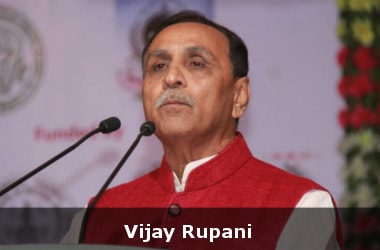 Gujarat CM Vijay Rupani dedicated the first laser technology based advanced AVMS RTO checkpost at Shamlaji in Aravalli district in India on 30th Dec 2016. Gujarat CM Vijay Rupani dedicated the first laser technology based advanced AVMS RTO checkpost at Shamlaji in Aravalli district in India on 30th Dec 2016.
The check post has advanced ray technology.
It was created at a cost of INR 4.72 crore.
Rupani has also laid the foundation of numerous developmental works worth INR 30 crore in tribal area of Aravalli district.
A commitment to make traffic check post well equipped with advanced tools will make it transparent and corruption-free.
All 16 check posts will be advanced, automatic and transparent with a cost of INR 35 crore in 2017.
State government will use this income for the welfare of poor, deprived and marginalized people.
The fulfillment has been made to provide transparent, sensitive, decisive and progressive government to the people.
State government has made 125 people oriented decisions within 100 days of ruling.
|
▼ NASA adds leap second to its missions [01-2-17]
 To maintain accuracy, NASA said its missions, including the Solar Dynamics Observatory, or SDO, which continuously watches the sun, will join official clocks around the world in adding a leap second to the final minute of 2016. To maintain accuracy, NASA said its missions, including the Solar Dynamics Observatory, or SDO, which continuously watches the sun, will join official clocks around the world in adding a leap second to the final minute of 2016.
On December 31, 2016, official clocks around the world will add a leap second at 23 hours, 59 minutes and 59 seconds Coordinated Universal Time (UTC).
Clocks do this to keep in sync with Earth's rotation, which gradually slows down over time. When the dinosaurs roamed Earth, for example, our globe took only 23 hours to make a complete rotation. In space, millisecond accuracy is crucial to understanding how satellites orbit.
SDO moves about 1.9 miles every second. So does every other object in orbit near SDO. We all have to use the same time to make sure our collision avoidance programs are accurate. So we all add a leap second to the end of 2016, delaying 2017 by one second.
The leap second is also key to making sure that SDO is in sync with the Coordinated Universal Time used to label each of its images.
Designed to help us understand the sun's influence on Earth and Near-Earth space, SDO was launched in 2010.
It has a clock that counts the number of seconds since the beginning of the mission.
To convert that count to UTC requires knowing just how many leap seconds have been added to Earth-bound clocks since the mission started.
When the spacecraft wants to provide a time in UTC, it calls a software module that takes into consideration both the mission's second count and the number of leap seconds and then returns a time in UTC.
UTC - Coordinated Universal Time
- Coordinated Universal Time (UTC) is the basis for civil time today. This 24-hour time standard is kept using highly precise atomic clocks combined with the Earth's rotation
- UTC is the time standard commonly used across the world. The world's timing centers have agreed to keep their time scales closely synchronized - or coordinated - therefore the name Coordinated Universal Time.
- Universal Time (UT) was created at the Washington Meridian Conference in 1884. This is the basis for the 24-hour time zone system known today.
Two components are used to determine UTC
- International Atomic Time (TAI)
- Universal Time (UT1)
|
▼ Red planet Mars has purple rocks: NASA [01-2-17]
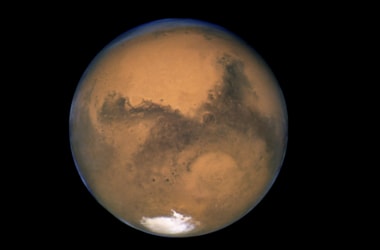 Curiosity Rover from NASA has captured an up-close image of the red planet's mountainous landscape, with purple-coloured rocks littered across the foreground. Curiosity Rover from NASA has captured an up-close image of the red planet's mountainous landscape, with purple-coloured rocks littered across the foreground.
Images are from Mast Camera (Mastcam) on Curiosity Mars rover showing purple-hued rocks near the rover's late-2016 location on lower Mount Sharp.
Variations in colour of the rocks hint at the diversity of their composition on lower Mount Sharp, NASA said.
The purple tone of the foreground rocks has been seen in other rocks where Curiosity's Chemical and Mineralogy (CheMin) instrument has detected hematite, it said.
Winds and windblown sand in this part of Curiosity's traverse and in this season tend to keep rocks relatively free of dust, which otherwise can cloak rocks' colour.
The three frames combined into a mosaic were acquired by the Mastcam's right-eye camera on November 10, during the 1,516th Martian day, or sol, of Curiosity's work on Mars.
|
| Chronology of events |
|
App Bharat Interface for Money (BHIM) is named after the main architect of Constitution of India Dr Bhim Rao Ambedkar.
|
|
American e-commerce giant Amazon has been awarded a US patent for a flying warehouse that would act as a launchpad for its drones to deliver certain products to customers’ doorsteps. Flying warehouse dubbed as Airborne fulfilment centre (AFC) will be similar to an airship.
|
|
Elon Musk-led aerospace manufacturer SpaceX has released images of Falcon Heavy rocket which is claimed to be most powerful operational rocket in the world.
|
|
An atomic clock at National Physical Laboratory (NPL) in New Delhi added ‘leap second’ (extra one second) to the Indian Standard Time (IST) at 5:29.59 hours on 1 January 2017 to synchronise with the Earth’s rotational clock.
|
|
The Union Ministry of Minority Affairs has launched Mobile App for Haj Pilgrimage. The app will provide information and facilitate e-payments for the pilgrimage.
|
|
Researchers developed a new non-invasive retinal imaging technique that could help prevent the onset of vision loss in diseases like glaucoma - the second leading cause of acquired blindness worldwide; The group was able to distinguish individual retinal ganglion cells (RGCs) which bear most of the responsibility of relaying visual information to the brain.
|
|
Google CEO Sundar Pichai, who is in a short trip to India unveiled two initiatives, Digital Unlocked and My Business Website, to provide technological edge to the SMBs.
|
|
Japanese startup Cerevo has developed ‘Taclim’, a pair of what it claims to be the world’s first virtual reality shoes for simulating different surfaces.
|
|
Fast radio bursts (FRBs) in 2016 detected by a telescope in New Mexico likely emanated from a dwarf galaxy some three billion light years from Earth, according to scientists; FRBs flash only for an micro-instant, and can emit as much energy in a millisecond as the Sun does in 10,000 years.
|
|
The Indian Space Research Organisation (ISRO) is set to launch record 103 satellites in a single flight in the first week of February 2017. It will be a major feat for India as so far no country has attempted it.
|
|
Scientists from Botanical Survey of India (BSI) have discovered a new species of Zingiber (commonly referred as ginger) from the Andaman and Nicobar Islands. The new species has been named as Zingiber pseudosquarrosum and belongs to genus Zingiber. It is used for its medicinal values by the local Particularly Vulnerable Tribal Groups (PVTGs) of the Andamans.
|
|
Scientists for the first time found potential evidence of the Ebola virus replication in the lungs of a person recovering from infection.
|
|
BSNL will provide three thousand hot spots at important places and has already initiated steps for automatic hook up points through wireless network; BSNL plans to connect 1,518 gram panchayats with Optical Fibre Cable (OFC) this year in Assam to ensure rural connectivity.
|
|
The human appendix, which is thought to be of little use to the body, may actually serve as a reservoir for beneficial gut bacteria, according to scientists.
|
|
Rather than one giant impact that knocked off part of early Earth and created the moon, a number of smaller collisions may have produced lots of mini-moons, Israeli scientists on Jan 9, 2016 and those mini-moons, over millions of years, may have clumped as per scientists.
|
|
Indian inventors contributed a record 658 patents to IBM in 2016. With 8,088 US patents, IBM's 2016 list covers a diverse range of inventions in artificial intelligence and cognitive computing, cognitive health to name a few.
|
|
India will for the first time introduce a vaccine against Rubella - a viral disease that infects pregnant women and leads to babies being born with cardiac, cerebral, ophthalmic and auditory defects.
|
|
Arconic, a materials science company based in New York will create a three mile-high skyscraper built from materials such as smog-eating surfaces and retractable balconies. They say that the tower could be built by 2062, using 3D technology.
|
|
According to a new study, Indian long pepper, widely used for spicing up food, contains a chemical called Piperlongumine (PL) which has anti-cancer properties.
|
|
The world’s largest social network Facebook is going to introduce new tools in Germany to help combat the spread of fabricated news stories (or fake news).
|
|
In India, about 95% of the population lives in malaria endemic areas. There were over 1.1 million confirmed cases of malaria in 2014
|
|
The National Aeronautics and Space Administration (NASA) has approved a mission to explore 16 Psyche, an iron-rich asteroid.
|
|
A baby has been born using a new type of three-person IVF to a previously infertile couple in Ukraine. In this case, doctors had used a method called pronuclear transfer. This is for the first time in the world this method has been used.
|
|
US military has successfully launched Geo-3 satellite mounted with Atlas V rocket into space to monitor possible missile attacks from space.
|
|
According the consolidated analysis of the WMO, the 2016 was hottest year on record. It surpassed the exceptionally high temperatures of 2015.
|
|
Physicists from Austria have created new form of Hydrogen i.e. negatively charged hydrogen clusters. It is a previously unseen form of hydrogen.
|
|
Scientists have spotted a new view of the dark, contorted centre of a sunspot that is nearly twice the diameter of the Earth using Atacama Large Millimetre/submillimetre Array (ALMA)
|
|
The Pune City Police has launched the “Beat Marshall Monitoring Mobile App” to map the real-time locations of patrolling teams from police stations on experimental basis.
|
|
Japan has successfully launched its first military communications satellite Kirameki-2 (kee-RAH-meh-kee 2) satellite. It was launched on board of H-2A rocket that lifted off from the Tanegashima Space Center in southern Japan
|
|
Next generation satellite INSAT-3DR has opened new frontiers in India’s weather forecasting and is set to equip the country with the ability to detect farm fires.
|